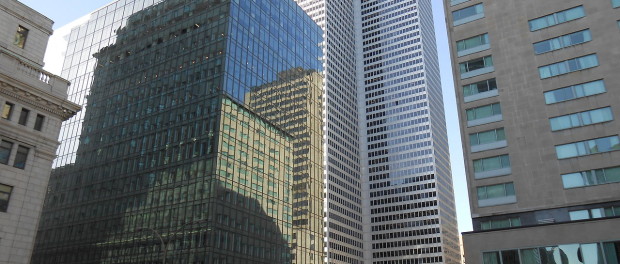47 Floors of Emphyteusis & Other Quebec Curios
 1 Place-Ville Marie, with 5 Place-Ville Marie in the foreground. Photo credit: Jean Gagnon/Wikimedia Commons.
1 Place-Ville Marie, with 5 Place-Ville Marie in the foreground. Photo credit: Jean Gagnon/Wikimedia Commons.
Ever wonder why the Royal Bank of Canada has its Montreal headquarters in 1 Place Ville-Marie? It started, like most business plans do, with a contract. In fact, they’re not allowed to move, at least for the next forty-five years. Back in the early 1960s, RBC formed a very long term rent agreement to move into Montreal’s most famous high-rise and stay there for ninety-nine years. The plan was concurrent with the construction of PVM itself, another ninety-nine-year contract. And in 1962, the date of completion of the first building that was to become PVM, RBC moved right in and started business.
Emphyteusis is a special type of contract in which two parties consent to an interesting type of property ownership: one person has the ability to use the property, reap any benefits the property may bring, and also partial rights to alienate the property (i.e. sell it), and another person maintains the other partial right to alienate the building (i.e. actually destroy it, but who would want to?). In the case of PVM, one party has temporary (as in the next forty-five years temporary) ownership of the building, whereas the second party has partial control of the building, ostensibly to protect their rights to the building. While the duration of the contract can only be one hundred years at a time (back when PVM was built, the maximum was ninety-nine), this contract can be renewed for another one hundred years. Otherwise, the contract ends and the second party gains full and complete ownership of the building, receiving PVM and all the perks of owning PVM—absolutely gratis.

1 Place Ville-Marie, with the Via Rail building (3 Place Ville-Marie) in the foreground. Photo credit: Jean Gagnon/Wikimedia Commons.
But for now, let us go back to the beginning. We start with a vacant terrain, and the promise that a building will be built to enrich the land. In 1958, construction begins with plans by two world-famous architects I. M. Pei (also known for the Louvre’s Pyramid in France) and Henry N. Cobb. The first building planned is the cross-shaped building that would be called the Royal Bank Building, later 1 Place-Ville Marie. The next phase of construction surrounded 1 PVM with three other smaller structures built in the mid-1960s. Setting new standards for Canadian architecture, 1 PVM features 47 total storeys, 43 of which are for office floors, and a grand height of 188 m (a bit more than half of the height of the Eiffel Tower), landing it the fourth tallest building on the Montreal skyline (1250 René Lévesque, 1000 de la Gauchetière, and Tour de la Bourse all beating PVM by a few metres). 1 PVM and its anchors are built in the International Style popular in the 1920s and 1930s and the favourite of architects that emphasised practicality with its maximum use of floor space and aesthetically pleasing (to some) glass and steel structure supported by reinforced concrete.
The name for the building itself was chosen by none other than Montreal mayor Jean Drapeau, the father of modern Montreal. Ville-Marie, of course, is the name of the original colony founded in 1642 that would become the downtown core of the city.
Visit Place Ville-Marie at none other than 1 Place Ville-Marie, or take a tour of the shops and businesses that PVM has to offer here.





